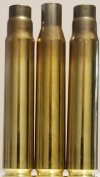nksmfamjp
Well-Known Member
- Joined
- Jan 5, 2004
- Messages
- 3,463
Anybody use this setup to look for thinning brass near the case head?
I do and found my 300 Sherman brass all scrapped after 6 firings. I'm pretty careful about sizing after firing. I target 0.003" shoulder bump because at my normal 0.002", there was still a bit of tightness in the final bolt close. Win 70 action.
I actually think it came from forming. Now the brass showed the brass thinned about 0.01" radially. After forming, I tested and saw 0.002-0.003" of this thinning.
So, my thought is my forming process was bad. I used a false shoulder created with a 0.312 (8mm) expander. I wonder if this wasn't enough. Bullets were jammed 0.005". I was using Peterson brass.
Now all I can find is new Starline. I'm thinking COW method and use 0.338 expander to get this false shoulder more solid.
Other advice? Am I heading the right way? Anything better.

